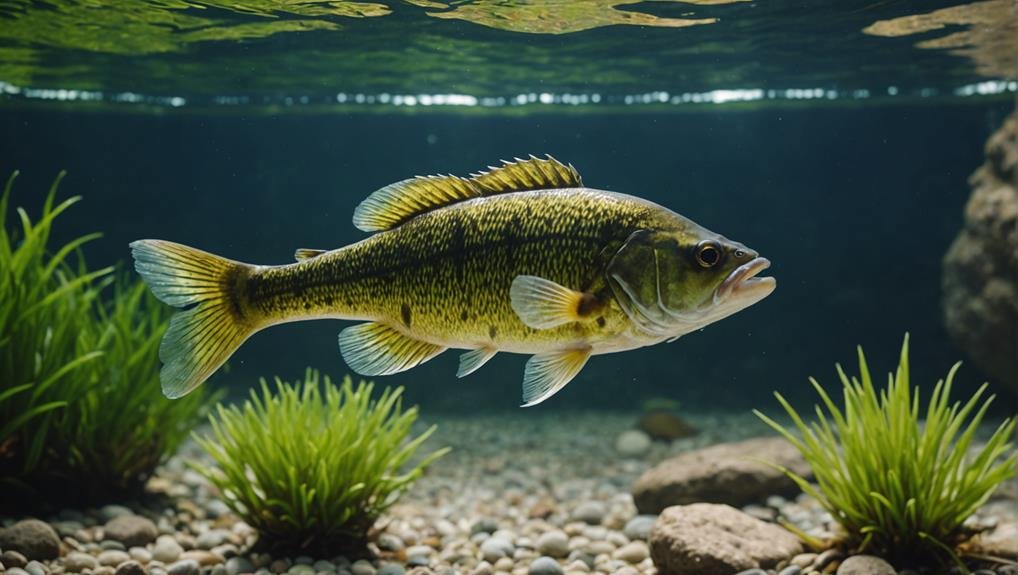If you’re an angler who appreciates a challenge, the smallmouth bass is a fascinating species to explore. Known for their slender bodies and striking golden-olive coloration, these fish are visually appealing and renowned for their fighting spirit. They thrive in clear, cool waters, often seeking rocky areas for cover and prey. But what sets them apart is their unique migration patterns and seasonal behaviors, which can make or break your fishing trip. Are you curious about how to optimize your tackle for these tenacious fighters? There’s much more to uncover.
Key Takeaways
- Smallmouth bass thrive in clear, cool waters with rocky substrates, indicating good water quality.
- They have golden-olive to dark brown coloration with a protruding jaw not extending beyond the eyes.
- Seasonal diet changes include feeding on baitfish, crayfish, and insects in the spring and larger prey in the fall.
- Ideal angling techniques include spinning and baitcasting rods with lures mimicking natural prey.
- Conservation efforts emphasize habitat protection and catch-and-release practices to sustain healthy bass populations.
Description
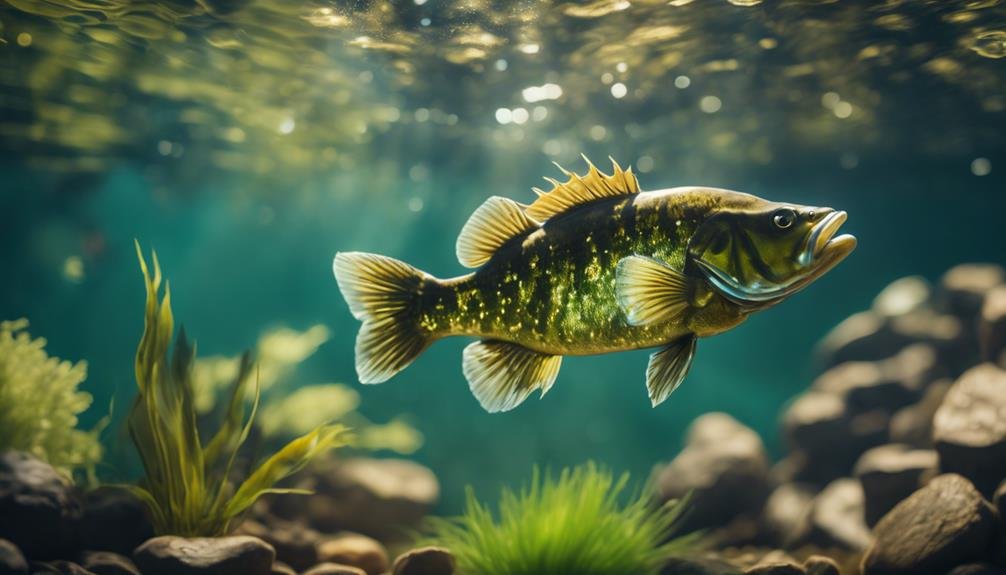
Smallmouth bass are easily distinguishable from other fish with their slender, muscular fusiform bodies and golden-olive to dark brown coloration. Their protruding jaw, which doesn’t extend beyond their eyes, sets them apart from largemouth bass. This distinct physical trait is something you’ll notice immediately when you spot one.
Smallmouth bass are a favorite among anglers, not just because they’re a challenge to catch but because of their remarkable fight once hooked. Anglers often target these fish for sport, appreciating their strong resistance and agility in the water. Smallmouth bass prefer clearer, cooler areas with deeper, faster-moving currents when you’re out on the water, making the chase even more exciting.
During the spawning season, which typically occurs in spring or early summer, female smallmouth bass can lay up to 21,100 eggs. This abundant spawning behavior maintains their continued presence in freshwater systems, much to the delight of fishing enthusiasts.
Habitat
Smallmouth bass thrives in clear, cool waters, often favoring deeper, faster-moving currents and rocky areas. You’ll typically find them in rivers and lakes where water clarity is high, as they’re intolerant of pollution. Their preference for rocky areas is linked to their feeding and spawning habits. These environments offer abundant cover and a rich supply of prey, making them ideal hunting grounds.
Smallmouth bass seek out stretches with moderate to swift currents and rocky bottoms in rivers. They’re commonly found near submerged boulders or ledges, which provide shelter and feeding opportunities.
Look for smallmouth bass in lakes in areas with similar characteristics—rocky shorelines, submerged rocks, and gravel beds are prime habitats. Water clarity is essential for smallmouth bass, as murky or polluted waters can significantly impact their health. Smallmouth bass act as indicators of a healthy aquatic ecosystem, so their presence often signals good water quality.
Spawning sites are also an important aspect of their habitat. Smallmouth bass require clean stone, rock, or gravel substrates during spring or early summer for successful spawning. They meticulously prepare these sites, ensuring the eggs are well-protected and oxygenated. This careful selection of spawning sites highlights their need for pristine environments.
Migration Patterns
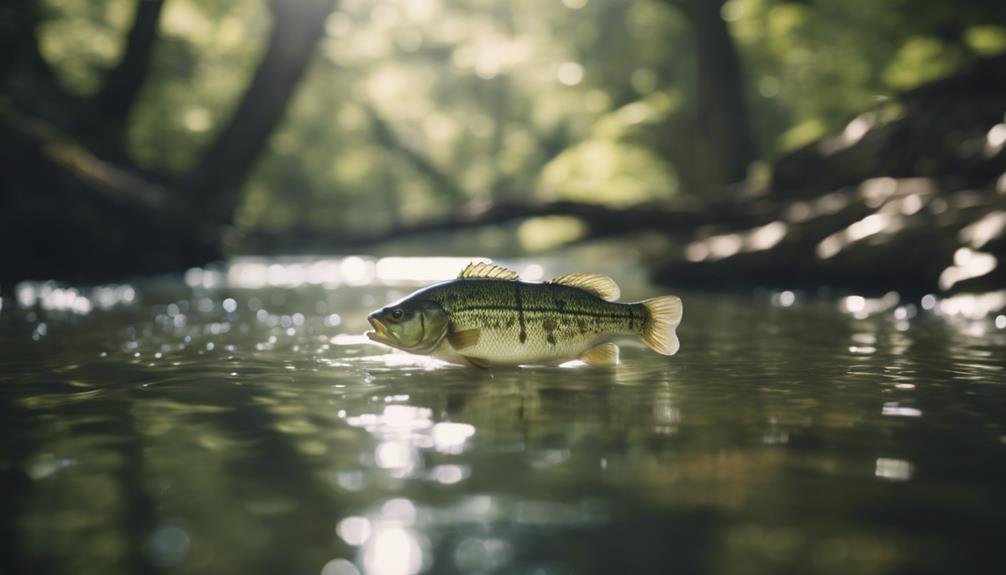
When water temperatures dip below 15°C, you’ll notice smallmouth bass migrating to deeper pools, sometimes traveling over 60 miles.
Their migration is influenced by seasonal changes and environmental factors, making them highly mobile.
Understanding these patterns is key for anglers, as they affect where and when you’ll find these fish.
Seasonal Movement Trends
Understanding the seasonal migration patterns of smallmouth bass can greatly enhance your fishing success by revealing their preferred locations throughout the year. During warm months, smallmouth bass exhibit river migrations, moving up and down rivers to cover more range. This movement is driven by their need to find ideal conditions for feeding and spawning.
By studying these movement patterns, you can anticipate where the bass will likely be and adjust your fishing strategies accordingly.
For example, smallmouth bass often migrate upstream to spawn in spring and early summer. They’re found in shallower, rocky areas with plenty of cover.
As the water warms, they move to deeper, cooler river sections. In the fall, they migrate downstream to prepare for winter, seeking out deeper pools and slower currents where they can conserve energy.
Environmental Influences
Environmental factors like water temperature and flow rates greatly influence the migration patterns of smallmouth bass. As water temperatures drop below 15°C, smallmouth bass migrate to deeper pools, sometimes covering distances up to 60 miles. This migration is vital for survival, helping them find suitable habitats during colder months.
Smallmouth bass can travel up to 12 miles daily, showcasing their remarkable ability to adapt and seek out the best environments. Understanding these migration patterns is essential for yearly locating smallmouth bass in rivers and lakes.
Spawning conditions also play a significant role in their movement. Smallmouth bass seek specific substrate conditions in spring or early summer to lay their eggs. They need gravel or rocky substrates, and their migration ensures they find these ideal spawning habitats.
Environmental influences, such as water temperature and flow rate changes, drive these migrations. By following these patterns, smallmouth bass demonstrate a strong adaptability to shifting environmental conditions. Knowing these details helps you understand where to find them during different seasons, whether for fishing or conservation efforts.
Their migration behaviors reflect their resilience and need for suitable habitats.
Feeding Behavior
When looking at smallmouth bass feeding behavior, you’ll notice they’re selective predators with distinct hunting techniques. Depending on the season, they target a variety of prey, including fish species like sculpins and threadfin shad, as well as insects and crustaceans.
Understanding their prey selection process and how it changes with the seasons can give you better insight into their survival strategies.
Prey Selection Process
Smallmouth bass exhibit a diverse and opportunistic feeding behavior, targeting a wide range of prey items depending on availability and environmental conditions. Their prey selection process is influenced by what’s accessible in their habitat. They’re munching on insect larvae, crustaceans, and small organisms.
Predatory fish also go after sculpins, threadfin shad, crayfish, and minnows. Surprisingly, smallmouth bass even resort to cannibalism, consuming the young of other bass pairs when necessary.
Understanding their feeding behavior is key to successful fishing. Their feeding activity peaks during early morning and dusk, making these times ideal for anglers to cast their lines. You should adjust your bait or lures accordingly, depending on what the bass are targeting.
If they’re after insect larvae, small, delicate lures effectively mimic these. Consider using more substantial, realistic bait for larger prey like crayfish or minnows.
Hunting Techniques Explained
During their hunting expeditions, smallmouth bass employs a combination of stealth and sudden bursts of speed to capture their prey. They exhibit opportunistic feeding behavior, preying on crustaceans, aquatic insects, and small organisms like sculpins, threadfin shad, crayfish, and minnows. Early morning and dusk are prime times for their feeding, making these periods ideal for fishing.
Understanding their hunting strategies can greatly enhance your bait choice and fishing techniques. Smallmouth bass often lie in wait, using underwater structures for cover before explosively ambushing their prey. This means you should select lures that mimic the natural movement of their preferred prey, such as crankbaits, jigs, or soft plastics resembling minnows and crayfish.
When you fish for smallmouth bass, consider the environment and prey selection. They love rocky terrains and areas with abundant cover. You increase your chances of a successful catch by mimicking the prey they’re hunting. Additionally, varying your retrieval speed can trigger predatory instincts, as it simulates the erratic movements of distressed prey.
Mastering these fishing techniques will improve your ability to effectively target smallmouth bass and capitalize on their unique feeding behavior.
Seasonal Diet Changes
To capitalize on smallmouth bass’s feeding behavior, it’s important to understand how their diet changes with the seasons. When water temperatures rise in spring, smallmouth bass actively feed on baitfish, crayfish, and insects to regain energy after winter. As an angler, focusing on these prey types can boost your success during this period.
Summer sees another shift: smallmouth bass often target smaller prey like insects and crustaceans. This adaptation helps them cope with the changing food availability. You’ll want to adjust your bait and lures to mimic these smaller creatures to keep up with their summer diet.
In fall, smallmouth bass are all about bulking up for the winter months. They go after larger prey such as shad and other fish. Larger lures resembling these prey items can be particularly effective during this season.
Here’s a quick reference table to help you choose the right bait throughout the year:
| Season | Primary Prey | Recommended Bait |
|---|---|---|
| Spring | Baitfish, Crayfish, Insects | Lures mimicking small fish, crayfish, and bugs |
| Summer | Insects, Crustaceans | Small insect-like or crustacean lures |
| Fall | Larger Fish | Large fish-imitating lures |
Understanding these seasonal diet changes will help you make informed decisions and improve your fishing success.
Spawning Season
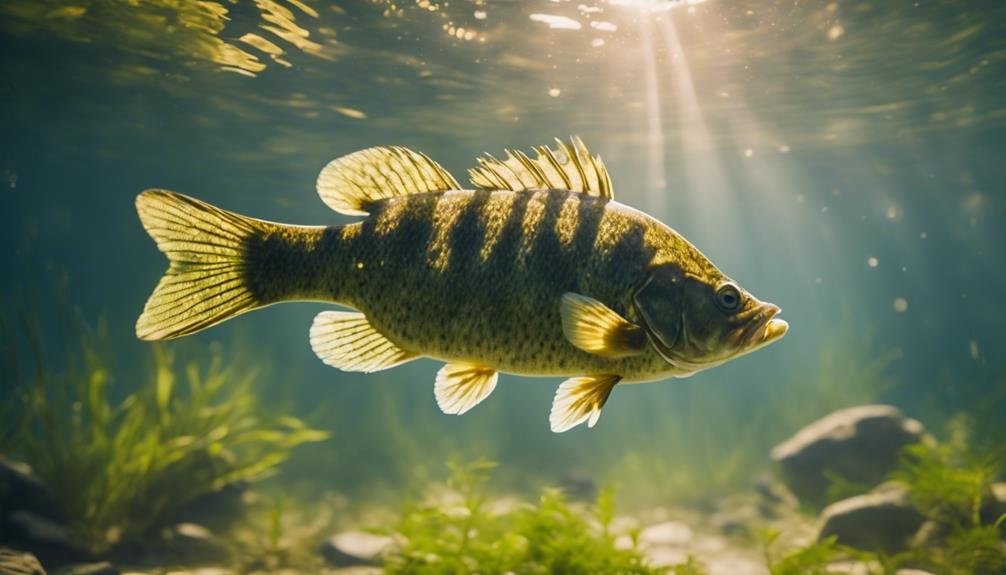
When the water temperature hits around 60°F in late spring, male smallmouth bass build nests in shallow waters to attract females for spawning. During this spawning season, these fish work meticulously to create nesting sites over gravel substrate, typically in depths ranging from 5 to 20 feet.
Male smallmouth bass are quite particular about their nesting sites, often selecting areas with ideal water temperatures and sufficient gravel substrate to guarantee the safety of their future offspring. Watching them clear away debris and prepare the perfect spot is fascinating. Once the nests are ready, males become highly territorial, aggressively defending nests from any potential threats.
Females are attracted to these well-prepared nests and can lay over 20,000 eggs during the spawning season. After spawning, the males continue to guard the nests vigilantly. Their primary goal is to protect the eggs and the newly hatched fry from predators and intruders, ensuring that generator the generation is critical for the smallmouth bass population, as successful spawning directly impacts their numbers in the ecosystem.
Angling Techniques
As you gear up to catch smallmouth bass, understanding effective angling techniques can make all the difference in your fishing success. Whether you prefer spinning, baitcasting, or fly fishing, each method has advantages depending on the conditions and your style.
Spinning reels are user-friendly and versatile, making them a great choice for beginners and seasoned anglers. They’re excellent for casting lightweight lures over long distances and ideal for targeting smallmouth bass in clear, calm waters.
On the other hand, Baitcasting reels offer greater precision and control, allowing you to place your lure exactly where you want it. This technique is particularly useful when fishing in areas with heavy cover or structure, where smallmouth bass are often found. Mastering baitcasting can take some practice, but the increased accuracy is well worth the effort.
Fly fishing is a unique challenge and incredibly rewarding when you hook into a feisty smallmouth bass. Using lightweight flies that imitate natural prey can entice these aggressive fish to strike.
Regardless of the method you choose, experimenting with different lures and techniques will help you become a more versatile and successful angler.
Recommended Tackle
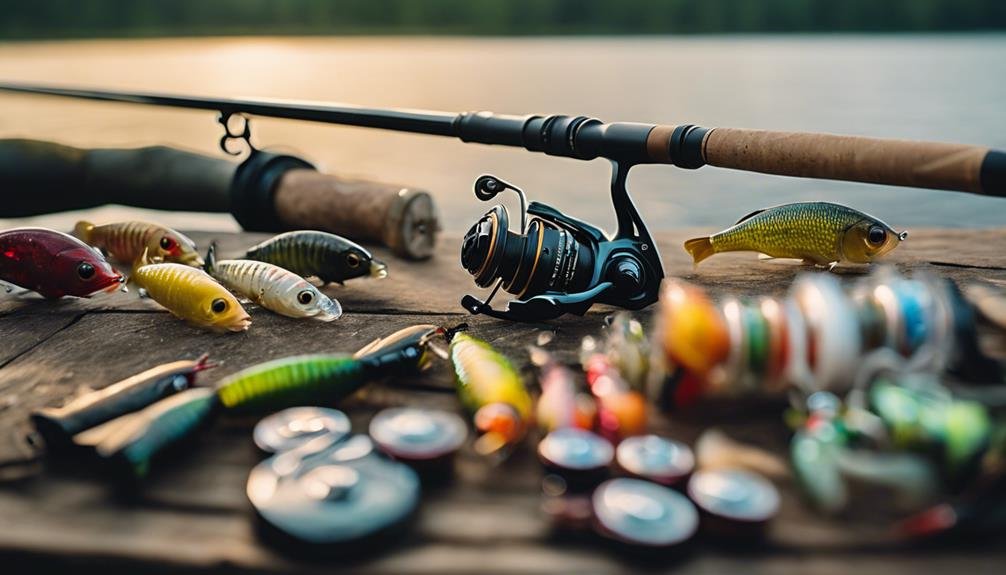
When selecting tackle for smallmouth bass, you should start with a medium-heavy spinning or baitcasting rod paired with a reliable reel.
Opt for a fishing line between 6-12 lb test for the best performance in various conditions.
Using a mix of lures, such as soft plastics, crankbaits, jerk baits, and topwater baits, will help you effectively target these feisty fish.
Rod and Reel Selection
Selecting the right rod and reel is essential for successfully targeting smallmouth bass. Regarding rod selection, opt for a medium to medium-heavy power rod with a fast action. This combination will help you handle the fighting strength of smallmouth bass, ensuring you can control the fish during the battle.
A spinning reel with a smooth drag system is important for reel selection. Look for a reel with a gear ratio that allows for varied retrieval speeds, giving you versatility when using different lures.
Speaking of lures, smallmouth bass are attracted to various bait types. Crankbaits, jerk baits, soft plastics, and topwater baits that mimic their natural prey can greatly increase your chances of a successful catch.
Ensure a quality landing net to further improve your fishing experience. This tool is necessary for safely landing and releasing smallmouth bass, minimizing stress on the fish, and supporting conservation efforts.
Choosing the right rod and reel, along with the appropriate lures and a reliable landing net, sets you up for an effective and responsible smallmouth bass fishing adventure. With these tools, you’ll be prepared to tackle the exciting challenges smallmouth bass offers.
Optimal Line Choices
Selecting the appropriate fishing line is crucial for effectively catching smallmouth bass. To maximize your success, consider using 6-12 pound test monofilament or fluorocarbon lines. These lines offer a good balance between sensitivity and strength, allowing you to detect subtle bites while still having the power to handle aggressive smallmouth bass.
Monofilament lines are versatile and forgiving, making them a great choice for beginners. They offer good stretch, which can be beneficial when a smallmouth bass makes a sudden run.
Fluorocarbon lines, on the other hand, are nearly invisible underwater and provide excellent abrasion resistance, making them ideal for clear water conditions where smallmouth bass are often found.
Braided lines in the 10-20 pound test range are worth considering if you’re fishing in heavy cover or targeting larger smallmouth bass. Braided lines offer superior strength and minimal stretch, helping you pull bass out of thick vegetation or deep water.
Pair your line choice with a medium-light to medium-action rod for spinning tackle to enhance casting distance and control. A medium to medium-heavy rod is preferred for baitcasting setups, especially when dealing with larger smallmouth bass in challenging environments.
Best Lure Types
For smallmouth bass, crankbaits, soft plastics, topwater lures, spinnerbaits, and jigs are some of the most effective lure types you can use. Each of these lures offers unique advantages that can help you land more fish.
Crankbaits are particularly effective because they mimic injured fish, triggering the predatory instincts of smallmouth bass.
Soft plastics, like Senkos and creature baits, are incredibly versatile. You can fish them in various ways to entice bites.
Topwater lures create surface commotion, perfect for attracting aggressive strikes in shallow waters.
Spinnerbaits are excellent for covering water quickly. Their flashy blades and vibration can draw strikes from bass actively searching for prey.
Jigs are another versatile option, letting you fish at different depths and adapt to changing conditions.
Here are some tips to keep in mind:
- Crankbaits: Use them to mimic injured or fleeing fish.
- Soft Plastics: Versatility is key; try different rigs to see what works best.
- Topwater Lures: Best for early morning or late evening when bass are feeding at the surface.
State Records
Holding the state record for smallmouth bass in Washington, Ray Wonacott’s 8.75-pound catch from the Columbia River in 1966 still stands unbeaten. This remarkable catch, made in Hanford Reach, highlights the impressive size potential of smallmouth bass in Washington. State records like this one are maintained to track exceptional angling achievements and provide valuable insights into the trophy potential of these fish.
If you’re an angler aiming to set a new state record, Washington’s Columbia River is a prime location to test your skills. The 8.75-pound smallmouth bass caught by Wonacott serves as a benchmark, challenging anglers to exceed this incredible feat. State records celebrate individual accomplishments and inspire the fishing community to pursue excellence.
Though Washington’s record has stood for decades, it’s worth noting that the all-tackle world record for smallmouth bass is even more impressive. Weighing in at 11 pounds and 15 ounces, the world record was set in 1955 at Dale Hollow Reservoir on the Tennessee-Kentucky border. These records illustrate the extraordinary growth potential of smallmouth bass in various regions, encouraging anglers everywhere to aim high and dream big.
Edibility
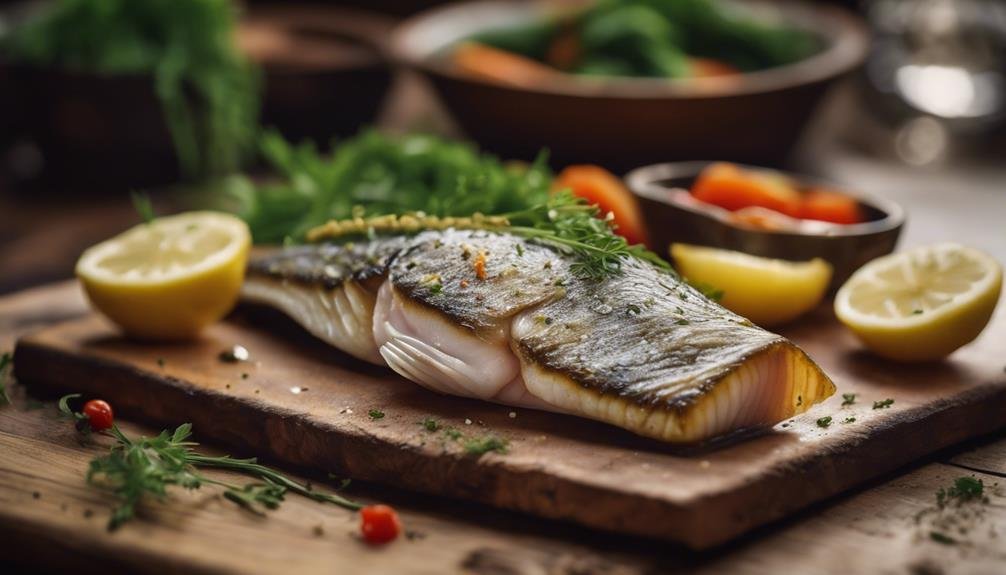
While the thrill of catching a record-breaking smallmouth bass is undeniable, their firm, mild-tasting meat also makes them a delight on the dinner table. Smallmouth bass’s edibility is one reason they’re so popular among anglers. Their meat is versatile and easy to cook, allowing you to prepare many delicious dishes.
Consider marinating the fish in milk to enhance your culinary experience with smallmouth bass. This simple step helps reduce any fishy flavor, resulting in a more enjoyable meal. You can grill, bake, or pan-fry the meat, which pairs nicely with various herbs and spices.
Here are some tips to make the most of your catch:
- Marinate in Milk: Soak the fillets for at least 30 minutes to eliminate any strong fishy taste.
- Season Generously: Use herbs like dill, parsley, and thyme to bring out the best flavors in the meat.
- Cook to Perfection: To keep the meat tender and juicy, avoid overcooking; aim for an internal temperature of 145°F.
Conservation Efforts
How can we guarantee the smallmouth bass thrives for generations to come? We can shield their environments from pollution and degradation by focusing on habitat protection. It starts with promoting catch-and-release practices among anglers. When you release your catch back into the water, you help sustain healthy bass populations.
Conservation organizations are at the forefront of these efforts. They monitor and manage smallmouth bass populations, ensuring their long-term survival. These groups understand that river ecosystem restoration is essential. Maintaining and restoring these ecosystems creates a stable habitat for smallmouth bass to flourish.
Collaborative initiatives also play a significant role. Government agencies, conservation groups, and local communities must work together. Your participation in these efforts can make a substantial difference. Whether supporting conservation organizations or practicing catch-and-release, you contribute to a healthier environment for the smallmouth bass.
Ultimately, it’s about collective action. We create a robust support network when everyone pitches in, from local communities to large organizations. Together, we can ensure that the smallmouth bass continues to thrive, providing enjoyment for anglers and maintaining ecological balance for years.
Conclusion
Understanding smallmouth bass habits is key to your pursuit of them. Because they love clear, rocky waters and seasonal migrations, you’ll need to adapt your techniques.
Their feeding behavior changes with the seasons, so adjust your bait accordingly. During spawning, protect their nests to guarantee future populations.
FAQs
Smallmouth bass are typically found in clear, cool, freshwater environments. Here’s where you’re most likely to find them:
- Rivers and Streams:
- Habitat: Smallmouth bass thrive in flowing waters, particularly rivers and streams with rocky or gravelly bottoms. They often stay near structures like submerged rocks, ledges, and riffles where they can ambush prey.
- Lakes and Reservoirs:
- Habitat: In lakes and reservoirs, smallmouth bass prefer areas with clear water, rocky shorelines, and submerged structures like logs, boulders, or artificial structures. They are usually found at varying depths, depending on the season.
- Cool, Deep Waters:
- Habitat: Smallmouth bass inhabit deeper, cooler waters than largemouth bass, especially during the warmer months. Look for them near drop-offs, underwater ridges, or deeper points.
What are the best baits for catching smallmouth bass?
The following baits are highly effective for catching smallmouth bass:
- Soft Plastics:
- Bait: Soft plastic lures like tubes, grubs, and worms are popular for smallmouth bass fishing. They can be rigged on a jig head, or Texas rigged to mimic the natural movement of baitfish or crawfish.
- Crankbaits:
- Bait: Crankbaits are excellent for covering water and locating smallmouth bass. Use medium-diving crankbaits that mimic the color and size of local baitfish. They work well around rocky structures and drop-offs.
- Jigs:
- Bait: Jigs, especially those paired with soft plastic trailers, effectively target smallmouth bass near rocks, ledges, and other underwater structures. Football jigs and finesse jigs are particularly popular.
- Spinnerbaits:
- Bait: Spinnerbaits with a compact profile are great for fishing in rivers and streams with active smallmouth bass. Their flash and vibration attract bass in various water conditions.
- Topwater Lures:
- Bait: Early morning or late evening is prime time for using topwater lures like poppers, walking baits, or buzz baits. These lures trigger explosive strikes when bass are feeding near the surface.
What are the best fishing techniques for smallmouth bass?
Effective techniques for catching smallmouth bass include:
- Drop Shotting:
- Technique: Drop shooting involves rigging a soft plastic bait above a weight, allowing the bait to hover just above the bottom. This technique is highly effective in deep water or when bass are suspended near the bottom.
- Casting and Retrieving:
- Technique: When using crankbaits or spinnerbaits, cast your lure near the structure and retrieve it steadily. Varying your retrieval speed can trigger bites from curious or aggressive bass.
- Dragging a Jig:
- Technique: Slowly dragging a jig across the bottom, especially in rocky areas, mimics the movement of crawfish, a favorite food of smallmouth bass. This technique is effective year-round.
- Vertical Jigging:
- Technique: Vertical jigging with a soft plastic bait or spoon can be highly effective in deeper waters. Drop your lure to the desired depth and use a subtle up-and-down motion to entice strikes.
- Drift Fishing:
- Technique: Drift fishing with live bait or soft plastics can be productive in rivers. Allow the current to carry your bait naturally through areas where smallmouth bass will likely hold.
What time of year is best for catching smallmouth bass?
The best time of year to catch smallmouth bass varies with the seasons:
- Spring (Pre-Spawn and Spawn):
- Time: Spring is one of the best times to catch smallmouth bass, especially during the pre-spawn and spawn periods. Bass are more aggressive and move into shallower waters to prepare for spawning. Look for them near rocky shorelines, gravel beds, and shallow flats.
- Summer:
- Time: During the summer, often move to deeper, cooler waters. Early morning and late evening are the most productive times, as bass come closer to the surface to feed.
- Fall:
- Time: Fall is another prime time for smallmouth bass fishing. As water temperatures cool, bass becomes more active, feeding heavily before the winter. They are often found in shallower waters and are more willing to strike various lures.
- Winter:
- Time: In winter, smallmouth bass are less active and tend to stay in deep waters. Fishing slows down but can still be caught using slow presentations like jigs or drop shot rigs in deep, rocky areas.
By understanding the habits and preferences of smallmouth bass, you can increase your chances of a successful catch. Whether fishing in rivers, lakes, or reservoirs, using the right baits and techniques will help you land this popular and spirited game fish.
